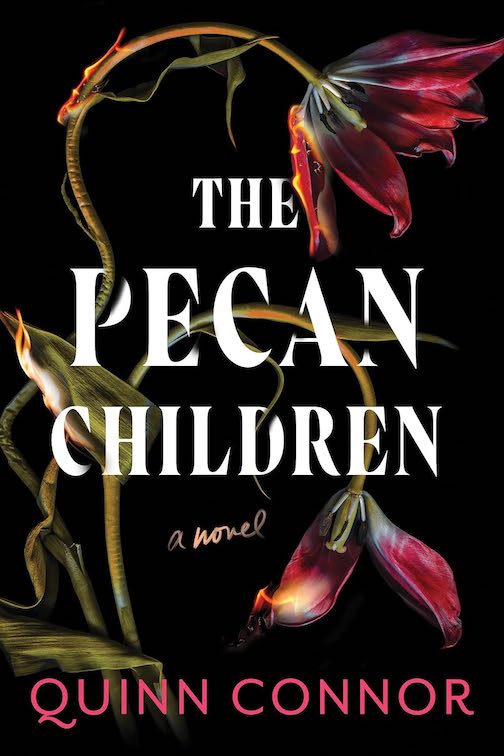YA Central?
With four new young-adult titles released this fall alone, Nashville authors are on the leading edge of the biggest news in publishing
During a period that can sometimes look like the end days for publishing, young-adult novels are hot. According to the Association of American Publishers, the category known as “Children’s/YA” is the fastest-growing segment in book-selling this year, showing a sales increase of more than sixty percent over 2011 levels and nearly 150 percent growth over the last six years. The success of mega-franchises like Twilight and The Hunger Games is one explanation for the surge in sales, but experts also point to the growing crossover appeal to adult audiences, estimating that as many as one-third of all YA titles sold are purchased by adults for their own use. Riding this wave of popularity are four Nashville-based authors—two of whom are new to the world of book publishing.
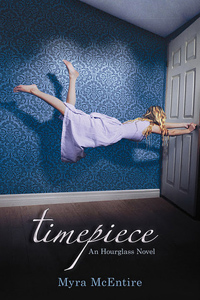 Sci-fi author Myra McEntire’s Timepiece is the sequel to her 2011 novel, Hourglass (Egmont, 352 pages, $17.99), in which orphaned teen Emerson Cole learns that she possesses the ability to travel through time. This discovery leads her to the Hourglass, a secret research group located in the small Southern town of Ivy Springs. Hourglass, led by Liam Ballard, is made up of other young people with unusual talents. Dr. Ballard’s son, Kaleb—who can read and influence emotions—is also a member of the group. In a surprising twist, it is Kaleb rather than Emerson who serves as the narrator of
Sci-fi author Myra McEntire’s Timepiece is the sequel to her 2011 novel, Hourglass (Egmont, 352 pages, $17.99), in which orphaned teen Emerson Cole learns that she possesses the ability to travel through time. This discovery leads her to the Hourglass, a secret research group located in the small Southern town of Ivy Springs. Hourglass, led by Liam Ballard, is made up of other young people with unusual talents. Dr. Ballard’s son, Kaleb—who can read and influence emotions—is also a member of the group. In a surprising twist, it is Kaleb rather than Emerson who serves as the narrator of
In
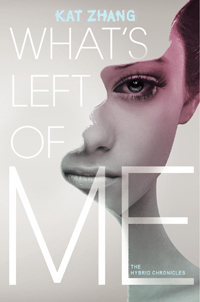 What’s Left of Me (Harper, 352 pages, $17.99), the debut novel from twenty-one-year-old Vanderbilt University student Kat Zhang imagines a world in which certain children are born with two souls—two distinct personalities inhabiting the same body. These “hybrids” are taught during early childhood that they soon must “settle,” or choose one personality to dominate while the second recedes into impassivity, eventually ceasing to exist. If this choice does not take place by the child’s tenth birthday, the government steps in; unsettled hybrids are considered unstable and dangerous. In fact, following a series of wars, the non-hybrid leaders of “the Americas” have taken great care to eradicate the adult hybrid population, link North and South America, and close the borders to foreigners. Addie and Eva are two souls occupying the body of a single seventh grader: they have never settled. Eva, the story’s narrator, is recessive and no longer able to assume control of their body, but her soul remains: “I was terrified,” Eva explains. “I was eleven years old, and though I’d been told my entire short life that it was only natural for the recessive soul to fade away, I didn’t want to go. I wanted twenty thousand more sunrises, three thousand more hot summer days at the pool. I wanted to know what it was like to have a first kiss… . I wanted life too badly. I refused to let go. I didn’t completely fade away.”
What’s Left of Me (Harper, 352 pages, $17.99), the debut novel from twenty-one-year-old Vanderbilt University student Kat Zhang imagines a world in which certain children are born with two souls—two distinct personalities inhabiting the same body. These “hybrids” are taught during early childhood that they soon must “settle,” or choose one personality to dominate while the second recedes into impassivity, eventually ceasing to exist. If this choice does not take place by the child’s tenth birthday, the government steps in; unsettled hybrids are considered unstable and dangerous. In fact, following a series of wars, the non-hybrid leaders of “the Americas” have taken great care to eradicate the adult hybrid population, link North and South America, and close the borders to foreigners. Addie and Eva are two souls occupying the body of a single seventh grader: they have never settled. Eva, the story’s narrator, is recessive and no longer able to assume control of their body, but her soul remains: “I was terrified,” Eva explains. “I was eleven years old, and though I’d been told my entire short life that it was only natural for the recessive soul to fade away, I didn’t want to go. I wanted twenty thousand more sunrises, three thousand more hot summer days at the pool. I wanted to know what it was like to have a first kiss… . I wanted life too badly. I refused to let go. I didn’t completely fade away.”
At school the girls meet Hally and her older brother Devon, who are also secretly hybrids. They and their alternate personalities, Lissa and Ryan, recognize Addie and Eva and reach out to them. At first Addie resists any contact as too risky, but Eva is desperate to meet other hybrids. Using a drug stolen from the hospital where their mother works, the siblings put Addie to sleep and help Eva learn how to emerge. Their experiments do not escape the notice of the authorities for long, and they are soon taken from their families and confined in the Nornand Clinic of Psychiatric Health for a “cure.” But it’s not their health the doctors are interested in: the friends soon uncover dangerous information about hybrid treatment and must find a way out of the facility for themselves and the other children being held there before it is too late.
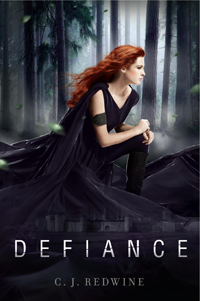 In Defiance (Balzer + Bray, 416 pages, $17.99), first-time fantasy author C. J. Redwine uses an alternating narrative to tell the story of sixteen-year-old Rachel Adams and nineteen-year-old Logan McEntire in their own words. Rachel, a strong-willed redhead, and Logan, an orphaned inventor, live inside the walled city of Baalboden, which is completely under the iron-fisted control of Commander Jason Chase. Outside the walls is the Wasteland, where unprotected travelers are vulnerable to bands of highwaymen and devastating attacks by the Cursed One, an immense, fire-breathing reptile that travels underground, periodically emerging, intent on destruction. The beast was released, along with many others of its kind, fifty years earlier when searchers for renewable sources of energy drilled too deeply into the earth’s crust. Commander Chase was among those who fought the creatures and secured a number of walled cities that provide safety—at least from dangers outside the city boundary. When Rachel’s father, expert tracker and government courier Jared Adams, does not return from his latest journey, he is declared dead and Rachel is placed under the protection of Logan, her father’s apprentice and, much to her embarrassment, the boy to whom she unsuccessfully offered her heart two years before.
In Defiance (Balzer + Bray, 416 pages, $17.99), first-time fantasy author C. J. Redwine uses an alternating narrative to tell the story of sixteen-year-old Rachel Adams and nineteen-year-old Logan McEntire in their own words. Rachel, a strong-willed redhead, and Logan, an orphaned inventor, live inside the walled city of Baalboden, which is completely under the iron-fisted control of Commander Jason Chase. Outside the walls is the Wasteland, where unprotected travelers are vulnerable to bands of highwaymen and devastating attacks by the Cursed One, an immense, fire-breathing reptile that travels underground, periodically emerging, intent on destruction. The beast was released, along with many others of its kind, fifty years earlier when searchers for renewable sources of energy drilled too deeply into the earth’s crust. Commander Chase was among those who fought the creatures and secured a number of walled cities that provide safety—at least from dangers outside the city boundary. When Rachel’s father, expert tracker and government courier Jared Adams, does not return from his latest journey, he is declared dead and Rachel is placed under the protection of Logan, her father’s apprentice and, much to her embarrassment, the boy to whom she unsuccessfully offered her heart two years before.
Desperate to search for her father—whom she believes to be alive and who trained her to fight, hunt, and survive in the Wasteland—Rachel is frustrated at every turn: by the patriarchal nature of Baalboden society, which expects women to be weak and obedient; by the Commander’s terrible threats against those she loves, including her beloved surrogate grandfather Oliver, unless she can find a mysterious package supposedly hidden by her father; and by the kind but determined Logan, who has vowed to protect her and who has a secret plan of his own to rescue her father. Logan knows what it’s like to lose a parent. When he was six years old, his own mother was executed in front of him, and he was cast out of society to fend for himself. “We move past the ridiculous wealth of Center Square, where multistoried homes gleam beneath the warmth of lanterns hung at their doorways, and no one inside knows what it’s like to go hungry,” he says. “When I was a boy, lonely and wild, I used to walk Center Square at night, imagining the perfect lives of the families who lived inside such beauty and wishing I belonged with one of them. That was before Oliver and Jared reached out to me, and I learned that true family is found in those who choose you.”
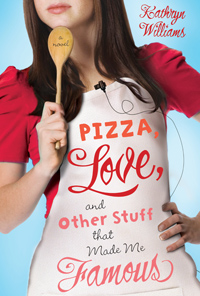 In Pizza, Love, and Other Stuff That Made Me Famous (Henry Holt, 240 pages, $16.99), three-time YA author Kathryn Williams turns to reality television for her source material. Sixteen-year-old Sophie Nicolaides has been working in her father’s Greek-Italian family restaurant in Washington, D.C., since she was ten years old. At first she is skeptical when her best friend, Alex Underhill, brings her an application for Teen Test Kitchen, a reality show for aspiring teen chefs, and insists that she try out. But if there’s one thing Sophie loves, it’s cooking: her dream is to open a restaurant of her own featuring more sophisticated fare than the traditional Mediterranean dishes of her dad’s Taverna Ristorante, and the competition just might be her ticket to meet famous chefs and be discovered.
In Pizza, Love, and Other Stuff That Made Me Famous (Henry Holt, 240 pages, $16.99), three-time YA author Kathryn Williams turns to reality television for her source material. Sixteen-year-old Sophie Nicolaides has been working in her father’s Greek-Italian family restaurant in Washington, D.C., since she was ten years old. At first she is skeptical when her best friend, Alex Underhill, brings her an application for Teen Test Kitchen, a reality show for aspiring teen chefs, and insists that she try out. But if there’s one thing Sophie loves, it’s cooking: her dream is to open a restaurant of her own featuring more sophisticated fare than the traditional Mediterranean dishes of her dad’s Taverna Ristorante, and the competition just might be her ticket to meet famous chefs and be discovered.
As Alex explains, “Here’s the plan: You get on Teen Test Kitchen. You showcase your sparkling wit, general fabulosity, and near-genius abilities with food. You win over America. You open your own restaurant in New York, and you hire yours truly as general manager.” But first Sophie must convince her traditional Greek father to let her go to California alone for seven weeks of cooking classes and cook-offs at the National Culinary Academy in the Napa Valley. And then she has to figure out how to stand out in a room full of excellent young chefs while cameras and microphones record her every misstep. Sophie fears it could be a recipe for disaster.
Naturally Pizza, Love, and Other Stuff That Made Me Famous provides actual recipes, too: adventurous readers can try their hands at some of the dishes Sophie makes, including Rosemary Lamb Chops with Spinach and White Bean Ragout and Lobster Ravioli with Champagne Cream Sauce. Despite the unwieldy title, Sophie’s kitchen adventures make for a light, enjoyable read that doesn’t take itself too seriously: a soufflé of fun for food-loving readers twelve and up.
